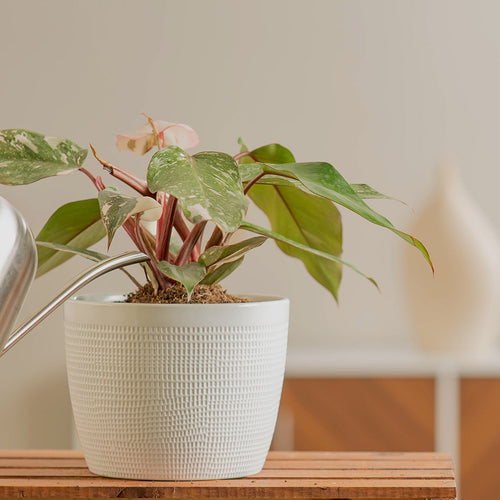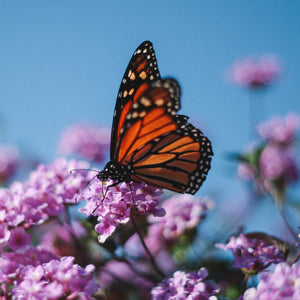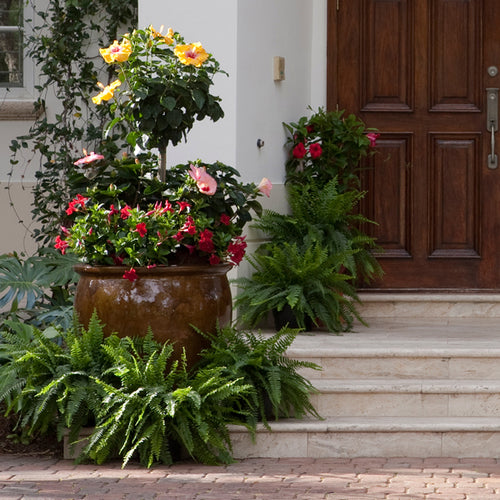
Pansy
You can’t go wrong with pansies (Viola) to brighten your early-spring and late fall plantings. These cheerful flowers are loved for their bold color, durability, and tolerance of frosty temperatures. They’re some of the first blooms you can plant to celebrate the start of the season. And, if you’re in a cold-winter climate, some of the last fall flowers you can enjoy before the snow flies. And if you’re in a mild-winter area, you can enjoy pansies all winter long.Pansies bloom in almost every color from white to deep purple black. It's easy to use these cool-season flowers to fit your favorite look. Many varieties bear blotches (dark markings that add depth and interest to the blossoms). While most pansies grow in tidy little mounds, some new types trail in pots, planters or baskets. Or use them as groundcovers when planted in the garden. Many pansies are fragrant, too.
Discover more annuals that can take the cold!

Sweet Alyssum
Sweet alyssum (Lobularia) is one of our must-have annual varieties because it’s so versatile. It looks good with any other plant you want to show it off with. Once it bursts into bloom, sweet alyssum transforms itself into a low-growing carpet of color. There are so many white, lavender, purple, or pink blooms that you can’t see the foliage. A beautiful accent plant, sweet alyssum is also delightfully fragrant.It’s often used as an edging plant or in the front of the border. But, this cool-weather annual flower also thrives in planters, and often used as a “spiller” element in container garden designs. Sweet alyssuum is elegant when displayed by itself in a low bowl-type pot as a centerpiece on a patio table. It’s exceptionally easy to grow in a sunny spot. To keep the show going, look for newer varieties such as White Knight or Silver Stream that have been bred with improved heat-tolerance.
Check out our Annual Flowers Bloom Guide to get spring-to-fall color in your yard!

Snapdragon
Every garden should have at least a few snapdragons (Antirrhinum). These annual flowers have become tried-and-true classics because they’re wonderfully easy to grow. Snapdragons thrive in practically any sunny spot. They don’t mind cool temperatures and continue to bloom all summer long in most areas. (They don’t love extended summer heat and humidity and may not do well over the summer in especially warm areas.) Snapdragons love garden beds, borders, and containers. They're versatile choices you can enjoy just about anywhere. The plant also adds a touch of whimsy to the garden. They earned their name because some think the individual flowers look like a dragon’s face. If you squeeze the back of the bloom, it appears to have jaws that open and snap shut.Snapdragons come in a couple of different types. Some grow tall, with majestic spikes of blooms that can reach 36 inches tall or more and suitable as dramatic cut flowers. Other snapdragon varieties are smaller, mounding plants that produce many small heads of bloom at a time rather than one large bloom spike. A few even have a trailing habit, making them a fun addition to hanging baskets. And, when selecting snapdragons, don’t forget to shop with your nose. Some snapdragons have delightfully fragrant flowers.
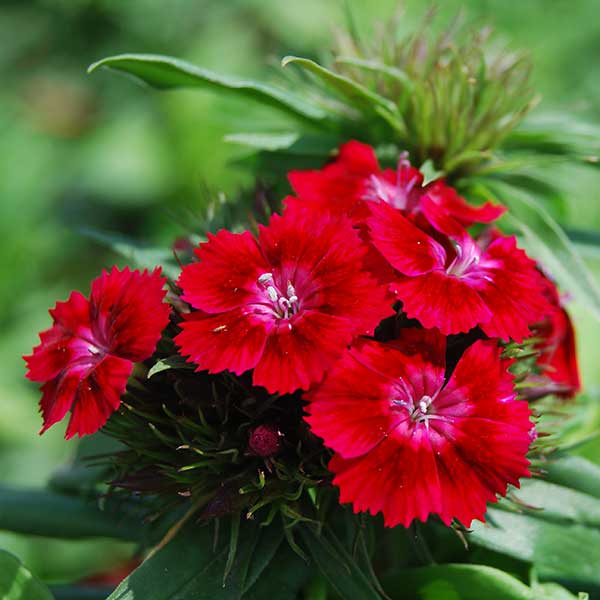
Dianthus
If fragrance is your goal, annual dianthus is a must-have flower for your garden. Most varieties have a distinctive spicy scent that’s often described as smelling of cloves. Dianthus is another excellent spring flower that thrives in cooler weather. Newer selections also boast excellent heat tolerance so in most areas, you can enjoy this delightful cottage-style flower all summer long.Most dianthus varieties are low-growing and perfect for the front of the border (as well as containers and planters). They bloom in shades of red, pink, lavender, and white. Some show off silvery foliage that adds to their visual appeal. Because most dianthus are small in stature, they’re ideal plants for outdoor centerpieces on patio tables.

Dusty Miller
Like sweet alyssum, dusty miller (Senecio cineraria) is one annual that accents every plant. Use it to create a beautiful combination, no matter what you plant it with. The soft green leaves are covered in silvery hair, giving the entire plant a silvery-white appearance. Dusty miller is fun to look at, as well experience from a tactile standpoint because the leaves are so soft and fuzzy.Most varieties of dusty miller have finely divided leaves, adding elegant texture to plantings. They accent fine-leafed plants like angelonia and marigold, and contrast bigger-leaf selections like coleus and geraniums. Dusty miller helps to add a cooling touch to hot-colored plantings filled with red, orange, and yellow flowers. Or, use it to help add softness to plantings with blue, purple, or pink shades.
See more silver-leaf plants!
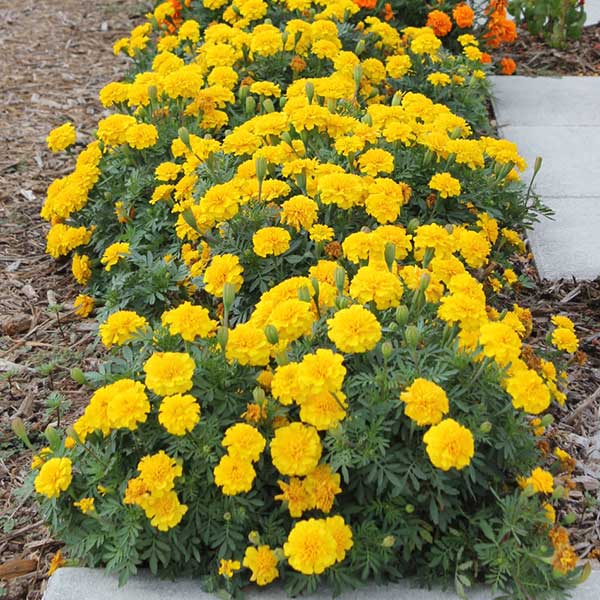
Marigold
Marigolds (Tagetes) are one of the most traditional annual flowers around. They’ve been planted and enjoyed by generations of gardeners. It’s a testament to both their beauty and how easy they are to grow. Just drop them in any sunny spot after all danger of frost has passed in spring and watch them bloom and bloom and bloom.Most marigolds bloom in shades of rusty-red, yellow, and orange. Marigold varieties fall into basic categories. African marigolds (Tagetes erecta) are large, capable of growing 40 inches tall or more, and having big flowers that can get 4 inches wide. French marigolds (Tagetes patula) stay smaller, usually topping out around 14 inches tall, and have flowers that can get 2 or 3 inches wide. While the flowers are smaller, there are typically many more of them than on their taller cousins.

Coleus
Plant coleus (Plectranthus) and you may quickly find it becomes your favorite annual garden plant! Coleus is a heat-loving tropical plant. It features variegated leaves in shades of green, chartreuse, gold, orange, red, pink, or purple – sometimes with multiple colors on the same leaf. Plant a group of one type of coleus together and it puts on a show you can see from down the block.Older coleus varieties could grow quite tall -- to 48 inches tall or more, making them excellent for the back of the border or large containers. Plant breeders have been working on smaller ones, too, and you can now find selections that stay 24 inches tall or less. These newer varieties tend to flower later in the season, too, allowing them to maintain a dense, bushy form without pruning.

Pentas
Like angelonia, pentas is a perfect plant for hot, sunny spots. This native of the tropics loves hot, steamy weather and, once established, blooms nonstop with clusters of red, pink, lavender, or white flowers all summer long (and all year long in frost-free areas!). These blossoms attract bees, butterflies, and hummingbirds into the garden, putting pentas toward the top of the list for pollinator plantings. It also thrives in pots and planters, as well as garden beds and borders.Pentas varieties are available in a range of sizes, from tall types that top out 48 inches tall or so to smaller selections that stay around 20 inches. There’s even a newer collection called Falling Star that has a semi-trailing habit, making it an outstanding annual groundcover or hanging basket plant.
Get our tips for creating a butterfly garden.
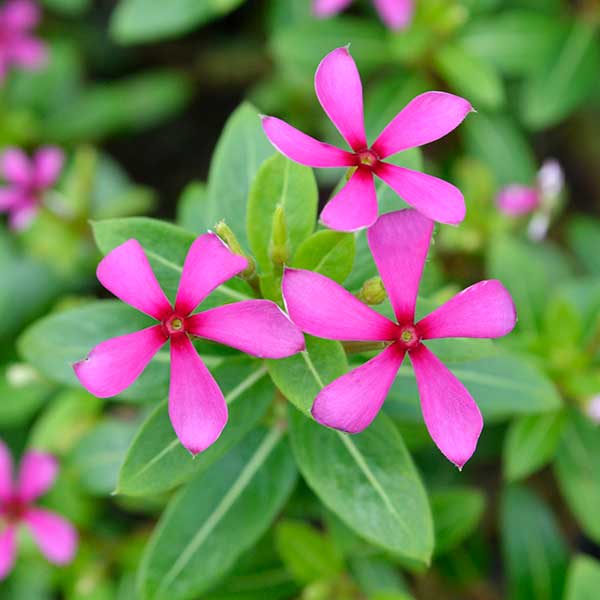
Vinca
Another summer survivor, annual vinca (Catharanthus) is a fabulous problem-solving plant. It blooms nonstop, holds up well to hot weather, tolerates drought, and is ignored by most deer and rabbits. Vinca blooms in a wide color range, from reds and pinks to coral and peach to lavenders and whites. Some newer types now show off blue-purple flowers.Most vinca selections have relatively large flowers, but keep an eye out for the Soiree Kawaii collection. This group offers loads of tiny blooms, giving the plant a whimsical, almost cottage-garden appearance. These small blooms are just as attractive to pollinators as their showy cousins.
Learn more about the different types of vinca -- and which are best for your yard.





